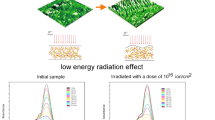Abstract
When accelerated electrons were irradiated with aqueous solutions of cadmium and lead salts containing methyl alcohol, metal precipitates with densities of 1.17 and 1.1 g/cm3 were obtained and porosities of 86.5 and 90.3%, respectively, and greater surface area. The process of metal deposition was studied and the radiation–chemical yields were calculated, which amounted to (1.7 ± 0.2) × 10–2 and (3.4 ± 0.3) × 10–2 g per 1 kGy for cadmium and lead, respectively, and 1.56 ± 0.05 metal atoms per 100 eV of absorbed radiation energy. The developed method can be promising for obtaining precipitation of pure and amorphous metals from aqueous solutions of their salts, for developing technologies for treating water effluents containing toxic metals, as well as for using porous cadmium and lead in the manufacture of electrical devices.








Similar content being viewed by others
REFERENCES
Klabunde, K.J., Stark, J.V., Koper, O., et al., in Nanophase Materials, Synthesis - Properties - Applications, Hadjipanayis, G.C. and Siegel, R.W., Eds., Dordrecht: Kluwer Academic, 1994, pp. 1–19.
Rochfort, G.L. and Rieke, R.D., Inorg. Chem.,1986, vol. 25, pp. 348–355. https://doi.org/10.1021/ic00223a024
Corrias, A., Ennas, G., Licheri, G., et al., J. Mater. Sci. Lett., 1988, vol. 7, pp. 407–409. https://doi.org/10.1007/BF01730759
Saida, J., Inoue, A., and Masumoto, T., Sci. Rep. Res. Inst., Tohoku Univ.,Ser. A, 1989, vol. 34, p. 205. https://doi.org/10.1007/BF02669880
Ershov, B.G., Ross. Khim. Zh., 2001, vol. 45, no. 3, pp. 20–30.
Henglein, A., Gutierrez, M., Janata, E., and Ershov, B.G., J. Phys. Chem., 1992, vol. 96, no. 11, pp. 4598–4602. https://doi.org/10.1021/j100190a084
Ershov, B.G., Usp. Khim., 1997, vol. 66, no. 2, pp. 103–116.
Bykov, G.L., Makarenkov, V.I., and Ershov, B.G., Russ. J. Appl. Chem., 2018, vol. 91, no. 4, pp. 555–559. https://doi.org/10.1134/S1070427218040043
Ershov, B.G. and Bykov, G.L., Radiat. Phys. Chem., 2018, vol. 153, pp. 245–250. https://doi.org/10.1016/j.radphyschem.2018.10.006
Wardman, P., J. Phys. Chem. Ref. Data, 1989, vol. 18, no. 4, pp. 1637–1755. https://doi.org/10.1063/1.555843
Pikaev, A.K., High Energy Chem., 2000, vol. 34, no. 2, pp. 55–73. https://doi.org/10.1007/BF02761832
Woods, R.J. and Pikaev, A.K., Applied Radiation Chemistry: Radiation Processing, New York: Wiley, 1994.
Kuracz, C.N., Waite, T.O., and Cooper, W.J., Radiat. Phys. Chem., 1995, vol. 45, no. 2, p. 299. https://doi.org/10.1016/0969-806X(94)00075-1
Khimicheskii entsiklopedicheskii slovar' (Chemical Encyclopaedical Dictionary), Knunyants, I.L., Ed., Moscow: Sovetskaya Entsiklopediya, 1983.
Kikoin, A.K. and Kikoin, I.K., Molekulyarnaya fizika (Molecular Physics), Moscow: Nauka, 1976.
Tikhomirov, V.K., Peny. Teoriya i praktika ikh polucheniya i razrusheniya (Foams. Theory and Practice for their Synthesizing and Destructing), Moscow: Khimiya, 1983.
Funding
This work was supported by the Ministry of Science and Higher Education of the Russian Federation using a UELV-10-10-S-70 linear accelerator at the Central Design Bureau of the Physical Mathematical Institute of the Institute of Physics and Economics of the Russian Academy of Sciences.
Author information
Authors and Affiliations
Corresponding author
Rights and permissions
About this article
Cite this article
Bykov, G.L., Ershov, B.G. The Formation of Sediments of Porous Metals during the Radiation–Chemical Reduction of Pb2+ and Cd2+ Ions in Water Solution. Prot Met Phys Chem Surf 56, 746–751 (2020). https://doi.org/10.1134/S2070205120040097
Received:
Revised:
Accepted:
Published:
Issue Date:
DOI: https://doi.org/10.1134/S2070205120040097




